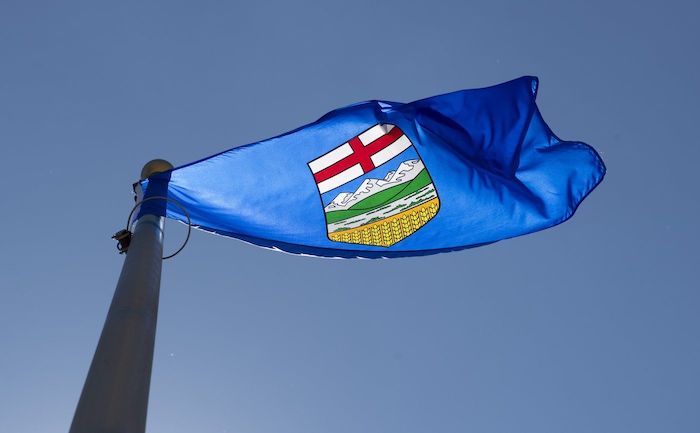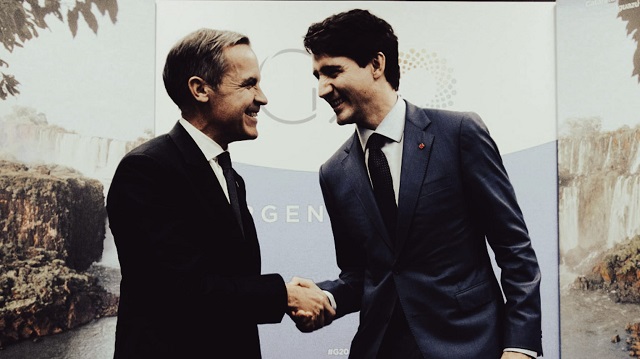Alberta
Alberta, Saskatchewan and Manitoba “Taking the lead on new nation-building projects”

Taking the lead on new nation-building projects
Alberta, Saskatchewan and Manitoba have signed an agreement to collaborate on joint economic corridor projects to boost trade and economic growth.
The signing of a memorandum of understanding between the governments of Alberta, Saskatchewan and Manitoba will foster the development of new economic corridors across the three provinces. This groundbreaking partnership aims to bolster economic growth and collaboration while strengthening the region’s position as a key player in the global market.
“Alberta is proud to partner with Saskatchewan and Manitoba, taking a leadership role in building new trade corridors that will help our provinces and our country. New nation-building projects need government cooperation and political will. We need to cut red tape. We need to get building things like we used to. We need to make good jobs and an affordable life a priority. We can start to show people that, yes, Canada is a place you can do business again.”
“The world needs what Saskatchewan has to offer. We rely on dependable, robust road, rail, air and port networks to ship our food, fuel and fertilizer across North America and around the globe.”
“Manitoba’s unique gateway and hub initiatives cannot develop in isolation, that is why external cooperative partnerships will leverage our initiatives for success. With similar trade and transport access such as distance to markets, reliance on international ports and railway services, and similar commodity basis, Saskatchewan and Alberta are natural key partners to work with on improving trade enablement through transportation.”
In its earliest days, Canada was united by nation-building economic projects such as the transcontinental railway, which tied the country together through improved travel and trade.
Over the last decade, regulatory uncertainty, anti-development policies and a lack of national leadership have cost provinces an opportunity to pursue projects that would have created thousands of jobs and billions of dollars in growth and investment.
The three provincial governments will work together to eliminate regulatory inefficiency and uncertainty to attract and develop nation-building projects. Alberta, Saskatchewan and Manitoba will coordinate to identify and prioritize strategic infrastructure that will enhance trade and transportation between the provinces and around the world. Through this, new economic corridors will be built to support the movement of critical resources, energy and utility projects, and secure national supply chains.
Quick facts
- The agreement will focus on enhancing critical infrastructure, improving the efficiency of interprovincial transportation networks and reducing regulatory hurdles. It will also identify opportunities to attract private sector investment and partner with Indigenous communities on economic corridor development.
- Economic corridors link markets in and out of Alberta, supporting the province’s economic, social and environmental activity.
- Economic corridors can involve a broad range of infrastructure, including transportation, energy, power, telecommunications and other utilities.
- In addition to physical infrastructure, corridors include service markets and the coordination of regulations and policies across multiple jurisdictions and sectors.
- According to Statistics Canada, Alberta exported more than $138 billion in goods in 2021.
- This includes goods shipped by pipeline and other modes, such as road, rail, air and marine.
- Non-pipeline exports of goods totalled more than $48 billion.
- Alberta Transportation and Economic Corridors will work and proactively partner with Indigenous communities to plan economic corridors for mutual economic benefit.
Alberta
Low oil prices could have big consequences for Alberta’s finances

From the Fraser Institute
By Tegan Hill
Amid the tariff war, the price of West Texas Intermediate oil—a common benchmark—recently dropped below US$60 per barrel. Given every $1 drop in oil prices is an estimated $750 million hit to provincial revenues, if oil prices remain low for long, there could be big implications for Alberta’s budget.
The Smith government already projects a $5.2 billion budget deficit in 2025/26 with continued deficits over the following two years. This year’s deficit is based on oil prices averaging US$68.00 per barrel. While the budget does include a $4 billion “contingency” for unforeseen events, given the economic and fiscal impact of Trump’s tariffs, it could quickly be eaten up.
Budget deficits come with costs for Albertans, who will already pay a projected $600 each in provincial government debt interest in 2025/26. That’s money that could have gone towards health care and education, or even tax relief.
Unfortunately, this is all part of the resource revenue rollercoaster that’s are all too familiar to Albertans.
Resource revenue (including oil and gas royalties) is inherently volatile. In the last 10 years alone, it has been as high as $25.2 billion in 2022/23 and as low as $2.8 billion in 2015/16. The provincial government typically enjoys budget surpluses—and increases government spending—when oil prices and resource revenue is relatively high, but is thrown into deficits when resource revenues inevitably fall.
Fortunately, the Smith government can mitigate this volatility.
The key is limiting the level of resource revenue included in the budget to a set stable amount. Any resource revenue above that stable amount is automatically saved in a rainy-day fund to be withdrawn to maintain that stable amount in the budget during years of relatively low resource revenue. The logic is simple: save during the good times so you can weather the storm during bad times.
Indeed, if the Smith government had created a rainy-day account in 2023, for example, it could have already built up a sizeable fund to help stabilize the budget when resource revenue declines. While the Smith government has deposited some money in the Heritage Fund in recent years, it has not created a dedicated rainy-day account or introduced a similar mechanism to help stabilize provincial finances.
Limiting the amount of resource revenue in the budget, particularly during times of relatively high resource revenue, also tempers demand for higher spending, which is only fiscally sustainable with permanently high resource revenues. In other words, if the government creates a rainy-day account, spending would become more closely align with stable ongoing levels of revenue.
And it’s not too late. To end the boom-bust cycle and finally help stabilize provincial finances, the Smith government should create a rainy-day account.
Alberta
Governments in Alberta should spur homebuilding amid population explosion

From the Fraser Institute
By Tegan Hill and Austin Thompson
In 2024, construction started on 47,827 housing units—the most since 48,336 units in 2007 when population growth was less than half of what it was in 2024.
Alberta has long been viewed as an oasis in Canada’s overheated housing market—a refuge for Canadians priced out of high-cost centres such as Vancouver and Toronto. But the oasis is starting to dry up. House prices and rents in the province have spiked by about one-third since the start of the pandemic. According to a recent Maru poll, more than 70 per cent of Calgarians and Edmontonians doubt they will ever be able to afford a home in their city. Which raises the question: how much longer can this go on?
Alberta’s housing affordability problem reflects a simple reality—not enough homes have been built to accommodate the province’s growing population. The result? More Albertans competing for the same homes and rental units, pushing prices higher.
Population growth has always been volatile in Alberta, but the recent surge, fuelled by record levels of immigration, is unprecedented. Alberta has set new population growth records every year since 2022, culminating in the largest-ever increase of 186,704 new residents in 2024—nearly 70 per cent more than the largest pre-pandemic increase in 2013.
Homebuilding has increased, but not enough to keep pace with the rise in population. In 2024, construction started on 47,827 housing units—the most since 48,336 units in 2007 when population growth was less than half of what it was in 2024.
Moreover, from 1972 to 2019, Alberta added 2.1 new residents (on average) for every housing unit started compared to 3.9 new residents for every housing unit started in 2024. Put differently, today nearly twice as many new residents are potentially competing for each new home compared to historical norms.
While Alberta attracts more Canadians from other provinces than any other province, federal immigration and residency policies drive Alberta’s population growth. So while the provincial government has little control over its population growth, provincial and municipal governments can affect the pace of homebuilding.
For example, recent provincial amendments to the city charters in Calgary and Edmonton have helped standardize building codes, which should minimize cost and complexity for builders who operate across different jurisdictions. Municipal zoning reforms in Calgary, Edmonton and Red Deer have made it easier to build higher-density housing, and Lethbridge and Medicine Hat may soon follow suit. These changes should make it easier and faster to build homes, helping Alberta maintain some of the least restrictive building rules and quickest approval timelines in Canada.
There is, however, room for improvement. Policymakers at both the provincial and municipal level should streamline rules for building, reduce regulatory uncertainty and development costs, and shorten timelines for permit approvals. Calgary, for instance, imposes fees on developers to fund a wide array of public infrastructure—including roads, sewers, libraries, even buses—while Edmonton currently only imposes fees to fund the construction of new firehalls.
It’s difficult to say how long Alberta’s housing affordability woes will endure, but the situation is unlikely to improve unless homebuilding increases, spurred by government policies that facilitate more development.
-

 2025 Federal Election23 hours ago
2025 Federal Election23 hours agoNine Dead After SUV Plows Into Vancouver Festival Crowd, Raising Election-Eve Concerns Over Public Safety
-

 2025 Federal Election20 hours ago
2025 Federal Election20 hours agoMark Carney: Our Number-One Alberta Separatist
-

 Opinion2 days ago
Opinion2 days agoCanadians Must Turn Out in Historic Numbers—Following Taiwan’s Example to Defeat PRC Election Interference
-

 International1 day ago
International1 day agoJeffrey Epstein accuser Virginia Giuffre reportedly dies by suicide
-

 C2C Journal2 days ago
C2C Journal2 days ago“Freedom of Expression Should Win Every Time”: In Conversation with Freedom Convoy Trial Lawyer Lawrence Greenspon
-

 International2 days ago
International2 days agoHistory in the making? Trump, Zelensky hold meeting about Ukraine war in Vatican ahead of Francis’ funeral
-

 2025 Federal Election24 hours ago
2025 Federal Election24 hours agoColumnist warns Carney Liberals will consider a home equity tax on primary residences
-

 2025 Federal Election13 hours ago
2025 Federal Election13 hours agoCanada is squandering the greatest oil opportunity on Earth


